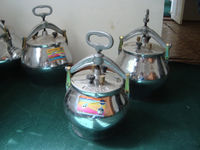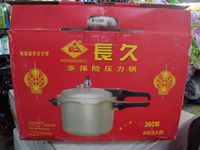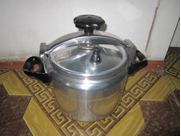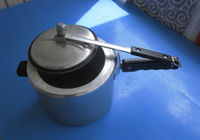Knowledge fuels change - Support energypedia!
For over 10 years, energypedia has been connecting energy experts around the world — helping them share knowledge, learn from each other, and accelerate the global energy transition.
Today, we ask for your support to keep this platform free and accessible to all.
Even a small contribution makes a big difference! If just 10–20% of our 60,000+ monthly visitors donated the equivalent of a cup of coffee — €5 — Energypedia would be fully funded for a whole year.
Is the knowledge you’ve gained through Energypedia this year worth €5 or more?
Your donation keeps the platform running, helps us create new knowledge products, and contributes directly to achieving SDG 7.
Thank you for your support, your donation, big or small, truly matters!
Difference between revisions of "Pressure Cookers"
***** (***** | *****) (Created page with "Pressure cookers are special cooking pots that can be sealed airtight and allow pressure to build up inside. A mechanical device (screws or interlocking parts) presses the pot...") |
***** (***** | *****) m |
||
| Line 1: | Line 1: | ||
| + | |||
| + | [[File:GIZ HERA Cooking Energy Compendium small.png|left|831px|GIZ HERA Cooking Energy Compendium|alt=GIZ HERA Cooking Energy Compendium small.png|link=GIZ HERA Cooking Energy Compendium]]<br/>[[GIZ HERA Cooking Energy Compendium#Basics about Cooking Energy|Basics]] | [[GIZ HERA Cooking Energy Compendium#Policy Advice on Cooking Energy|Policy Advice]] | [[GIZ HERA Cooking Energy Compendium#Planning Improved Cook Stove .28ICS.29 Interventions|Planning]] | [[GIZ HERA Cooking Energy Compendium#Designing and Implementing Improved Cookstoves .28ICS.29 Supply Interventions|Designing and Implementing (ICS Supply)]]| '''[[GIZ HERA Cooking Energy Compendium#Cooking Energy Technologies and Practices|Technologies and Practices]]''' | [[GIZ HERA Cooking Energy Compendium#Designing and Implementing Woodfuel Supply Interventions|Designing and Implementing (Woodfuel Supply)]]| [[GIZ HERA Cooking Energy Compendium#Climate Change Related Issues|Climate Change]] | ||
| + | |||
| + | = Introduction - Technology = | ||
| + | |||
Pressure cookers are special cooking pots that can be sealed airtight and allow pressure to build up inside. A mechanical device (screws or interlocking parts) presses the pot-lid firmly against the pot-body. A gasket or seal in between the lid and the pot prevents steam to escape from the pot. With rising heat, the steam pressure inside the pot builds up beyond atmospheric pressure, allowing the temperatures to rise well above boiling point. This design enables to save time, energy, and resources. The temperature inside a pressure cooker can well go beyond 110° C, which reduces the time needed to cook food. In addition, very little steam escapes between the pot and the lid, thus requiring less water to cook the food.<ref name="http://en.wikipedia.org/w/index.php?title=Pressure_cooking&redirect=no#Science_of_pressure_cooking">http://en.wikipedia.org/w/index.php?title=Pressure_cooking&redirect=no#Science_of_pressure_cooking</ref> | Pressure cookers are special cooking pots that can be sealed airtight and allow pressure to build up inside. A mechanical device (screws or interlocking parts) presses the pot-lid firmly against the pot-body. A gasket or seal in between the lid and the pot prevents steam to escape from the pot. With rising heat, the steam pressure inside the pot builds up beyond atmospheric pressure, allowing the temperatures to rise well above boiling point. This design enables to save time, energy, and resources. The temperature inside a pressure cooker can well go beyond 110° C, which reduces the time needed to cook food. In addition, very little steam escapes between the pot and the lid, thus requiring less water to cook the food.<ref name="http://en.wikipedia.org/w/index.php?title=Pressure_cooking&redirect=no#Science_of_pressure_cooking">http://en.wikipedia.org/w/index.php?title=Pressure_cooking&redirect=no#Science_of_pressure_cooking</ref> | ||
| + | |||
| + | |||
| + | |||
| + | = Market and Field of Application = | ||
So far, pressure cookers have often been overlooked as potential components of efficient integrated cooking systems. They are normally made from thick aluminium or stainless steel, which makes them heavier and more expensive than conventional pots. They might also be difficult to produce in many developing countries. Prices are seldom below 20 US$, top-of-the range products easily exceed 200 US$. In regions, where pressure cookers are not commonly used, the relatively high costs of purchase are an obstacle for their spread out. Pressure cookers are more popular in urban areas, where the fuel has to be paid for in cash, and in regions, where local food can easily be cooked with pressure cookers: especially in Asia (China, Nepal, and India).<br/> | So far, pressure cookers have often been overlooked as potential components of efficient integrated cooking systems. They are normally made from thick aluminium or stainless steel, which makes them heavier and more expensive than conventional pots. They might also be difficult to produce in many developing countries. Prices are seldom below 20 US$, top-of-the range products easily exceed 200 US$. In regions, where pressure cookers are not commonly used, the relatively high costs of purchase are an obstacle for their spread out. Pressure cookers are more popular in urban areas, where the fuel has to be paid for in cash, and in regions, where local food can easily be cooked with pressure cookers: especially in Asia (China, Nepal, and India).<br/> | ||
| Line 59: | Line 68: | ||
<br/> | <br/> | ||
| − | + | = Advantages of Pressure Cookers = | |
*Pressure cookers can be used with most fuel types and stoves. | *Pressure cookers can be used with most fuel types and stoves. | ||
| Line 71: | Line 80: | ||
<br/> | <br/> | ||
| − | + | = Disadvantages of Pressure Cookers = | |
*More expensive than normal pots. | *More expensive than normal pots. | ||
| Line 84: | Line 93: | ||
<br/> | <br/> | ||
| − | + | = Safety Aspects = | |
If appropriately used and maintained, pressure cookers are safe to use. However, several important considerations should be kept in mind. To prevent explosions, regulators and safety valves let surplus pressure escape. It is really important that the safety valve and regulator are fully functional. Pressure cookers should never be filled until the top of the pot, as the regulator and the valve can get blocked easily. In case of too high pressure the steam can abruptly escape, which can lead to scalding. In addition, pressure cookers made from aluminium should not be cleaned with sharp items or with soda, as afterwards aluminium can enter the food, which will cause diseases. | If appropriately used and maintained, pressure cookers are safe to use. However, several important considerations should be kept in mind. To prevent explosions, regulators and safety valves let surplus pressure escape. It is really important that the safety valve and regulator are fully functional. Pressure cookers should never be filled until the top of the pot, as the regulator and the valve can get blocked easily. In case of too high pressure the steam can abruptly escape, which can lead to scalding. In addition, pressure cookers made from aluminium should not be cleaned with sharp items or with soda, as afterwards aluminium can enter the food, which will cause diseases. | ||
| Line 92: | Line 101: | ||
<br/> | <br/> | ||
| − | + | = Further Information<br/> = | |
*Everything about pressure cookers: Pressure-Cooking Times & Instructions: [http://fastcooking.ca/pressure_cookers/cooking_times_pressure_cooker.php fastcooking.ca - pressure cookers] | *Everything about pressure cookers: Pressure-Cooking Times & Instructions: [http://fastcooking.ca/pressure_cookers/cooking_times_pressure_cooker.php fastcooking.ca - pressure cookers] | ||
| Line 104: | Line 113: | ||
<br/> | <br/> | ||
| − | + | = References = | |
| + | |||
| + | This article was originally published by [http://www.giz.de/fachexpertise/html/2769.html GIZ HERA]. It is basically based on experiences, lessons learned and information gathered by GIZ cook stove projects. You can find more information about the authors and experts of the original “Cooking Energy Compendium” in the [[Imprint - GIZ HERA Cooking Energy Compendium|Imprint]]. | ||
| + | |||
| + | <br/> | ||
<references /> | <references /> | ||
| Line 110: | Line 123: | ||
<br/> | <br/> | ||
| − | <br/> | + | top of page |
| + | |||
| + | <br/>[[GIZ HERA Cooking Energy Compendium|--> Back to Overview GIZ HERA Cooking Energy Compendium]] | ||
Revision as of 14:04, 19 December 2016
Basics | Policy Advice | Planning | Designing and Implementing (ICS Supply)| Technologies and Practices | Designing and Implementing (Woodfuel Supply)| Climate Change
Introduction - Technology
Pressure cookers are special cooking pots that can be sealed airtight and allow pressure to build up inside. A mechanical device (screws or interlocking parts) presses the pot-lid firmly against the pot-body. A gasket or seal in between the lid and the pot prevents steam to escape from the pot. With rising heat, the steam pressure inside the pot builds up beyond atmospheric pressure, allowing the temperatures to rise well above boiling point. This design enables to save time, energy, and resources. The temperature inside a pressure cooker can well go beyond 110° C, which reduces the time needed to cook food. In addition, very little steam escapes between the pot and the lid, thus requiring less water to cook the food.[1]
Market and Field of Application
So far, pressure cookers have often been overlooked as potential components of efficient integrated cooking systems. They are normally made from thick aluminium or stainless steel, which makes them heavier and more expensive than conventional pots. They might also be difficult to produce in many developing countries. Prices are seldom below 20 US$, top-of-the range products easily exceed 200 US$. In regions, where pressure cookers are not commonly used, the relatively high costs of purchase are an obstacle for their spread out. Pressure cookers are more popular in urban areas, where the fuel has to be paid for in cash, and in regions, where local food can easily be cooked with pressure cookers: especially in Asia (China, Nepal, and India).
Worldwide, different models of pressure cookers are offered on markets. In order to find the most appropriate model, different features have to be taken into consideration, such as price, size, main kind of stove applied (electric, gas, fire), durability, and maintenance. Additionally, the replacement of the seals is an important point to consider. The following pictures show examples of pressure cookers found during a market analysis in Tajikistan in 2010/2011.
Pressure cookers can be used with nearly any stove and fuel type. When used on an open wood-fire, however, care should be taken that non-metal parts do not get exposed to the flames, otherwise they might melt or burn.
Pressure cooker can also be used in combination with a fireless cooker, such as a heat retention bag or box (discussed later). With this type of combination, fuel savings of 80% were measured in a test in Tajikistan carried out with Welthungerhilfe[2]. If the pot is put into a heat retention bag or box before the pressure valve releases steam, no energy in form of steam is lost. Information such as cooking time to boil, cooking time after boil is reached, and time required for the pot to remain in the heat bag are necessary for, e.g, instruction manuals. This information depends on the altitude, food to be cooked, and type of pressure cooker and heat retention bag.
Pressure cookers can also be utilized for cooking traditional cooking recipes. However, user training and awareness training are necessary to show users how to cook traditional recipes on the new equipment. One example of doing this is to handout a pressure cooker cookbook for traditional dishes.
In higher altitudes the low atmospheric pressure reduces the boiling point of water. Therefore the cooking is slower and requires more fuel or food remains undercooked. The required boiling time for softening the food is between one fourth and one fifth of the normal boiling time, depending on the altitude.
As the steam within the pressure cooker creates a higher boiling temperature, the potential of pressure cookers to save fuel and cooking time rises with increasing altitudes, as shown in the following table:[2]
| Altitude in meters | Sea level | 1000 m | 1500 m | 2250 m | 3000 m | Pressure cooker A |
| Boiling temp. degrees Celsius | 100 ºC | 96.6 ºC |
95 ºC | 92.2 ºC |
90 ºC |
118 ºC ~ 120 ºC |
Advantages of Pressure Cookers
- Pressure cookers can be used with most fuel types and stoves.
- At high altitudes where the boiling point is lower, they offer great advantages to raise the temperature above 100°C and prevent food from being left undercooked.
- Cooking is much faster and thus the pressure cooker can save considerable amounts of time and energy.
- It is possible to sterilise goods using a pressure cooker.
- Nutrients and flavors are retained: Because foods cook quickly with a small amount of liquid in an almost airless environment, vitamins and minerals that are normally boiled away in the cooking process condense in the pot and absorb back into the food retaining the precious nutrients naturally found in our food.[3][4]
Disadvantages of Pressure Cookers
- More expensive than normal pots.
- As steam builds up inside, they cannot be used for frying or roasting.
- Can not be used for foods that need to be stirred during cooking (like maize porridge).
- Opening the cooker must be done carefully since hot steam, under pressure, can escape with force and scald the cook.
- Pressure cookers are not appropriate for dishes, where different ingredients need to be added at different times, as they cannot easily be opened during cooking.
- Seal between the pot and the lid wears out and must be replaced; thus a service system has to be in place.
- Cooking with a pressure cooker requires the change of accustomed cooking processes (behaviour change).
- Due to the hotter steam the risk of scalding is higher.[5]
Safety Aspects
If appropriately used and maintained, pressure cookers are safe to use. However, several important considerations should be kept in mind. To prevent explosions, regulators and safety valves let surplus pressure escape. It is really important that the safety valve and regulator are fully functional. Pressure cookers should never be filled until the top of the pot, as the regulator and the valve can get blocked easily. In case of too high pressure the steam can abruptly escape, which can lead to scalding. In addition, pressure cookers made from aluminium should not be cleaned with sharp items or with soda, as afterwards aluminium can enter the food, which will cause diseases.
Unfortunately, if the pressure cooker is poorly maintained or inappropriate used, the cooker can explode, which can result in serious injuries.[6][2]
Further Information
- Everything about pressure cookers: Pressure-Cooking Times & Instructions: fastcooking.ca - pressure cookers
http://discoverpressurecooking.com/index.html
- Manual on Pressure Cookers (*Russian): Manual PRESSURECOOKER
References
This article was originally published by GIZ HERA. It is basically based on experiences, lessons learned and information gathered by GIZ cook stove projects. You can find more information about the authors and experts of the original “Cooking Energy Compendium” in the Imprint.
- ↑ http://en.wikipedia.org/w/index.php?title=Pressure_cooking&redirect=no#Science_of_pressure_cooking
- ↑ 2.0 2.1 2.2 HEDON, Pressure Cooker Training, issue 57 - 2009. http://www.hedon.info/BP57_PressureCookerTraining?bl=y
- ↑ http://en.wikipedia.org/w/index.php?title=Pressure_cooking&redirect=no#Advantages
- ↑ http://discoverpressurecooking.com/advantages.html
- ↑ http://en.wikipedia.org/w/index.php?title=Pressure_cooking&redirect=no#Disadvantages
- ↑ http://en.wikipedia.org/w/index.php?title=Pressure_cooking&redirect=no#Safety_features
top of page
























